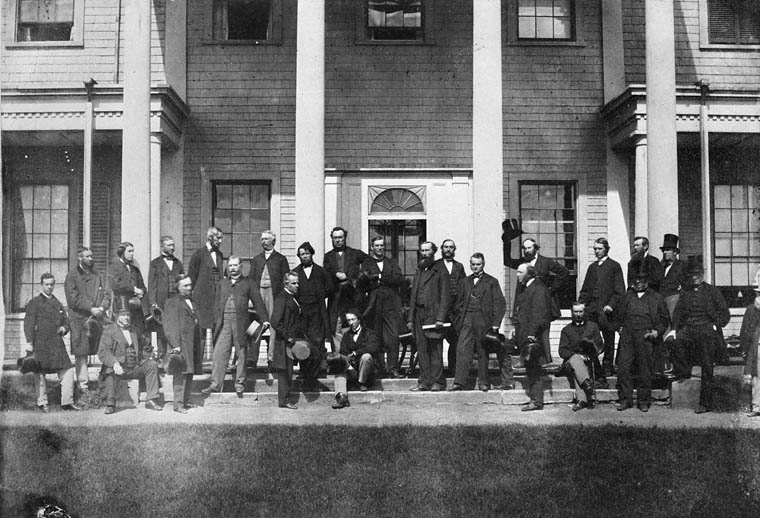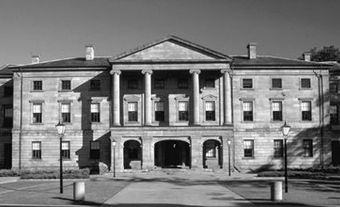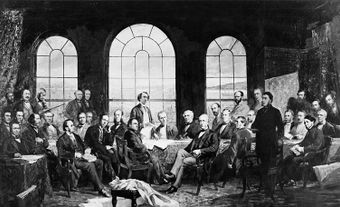The Constitution is Canada’s supreme law. It gives the country its legal framework. It defines the powers of both the federal and provincial governments. It overrides any other laws. The Constitution is not one document. It is a complex mix of British and Canadian laws. It also contains unwritten rules known as constitutional conventions.
(This article is a plain-language summary of the Constitution of Canada. If you are interested in reading about this topic in more depth, please see our full-length entry, Constitution of Canada.)

Constitution Act, 1867
The British North America Act (BNA Act) created the Dominion of Canada. The Act was passed by the British Parliament. It came into effect on 1 July 1867. The Act is the founding document of Canada’s Constitution. It outlines how governments in Canada are to be structured. It also describes which powers are given to Parliament and to the provinces.
Federal control includes: citizenship; Indigenous peoples; national defence; criminal law; banking; money; the postal service; and the census. Provincial control includes: municipalities; hospitals; school systems; property; and provincial courts. There is joint federal-provincial control over agriculture and immigration.
The BNA Act was renamed the Constitution Act, 1867 in 1982. This took place when the Constitution was patriated (taken back) from Britain.

Parliament and the Legislatures
The federal Parliament is composed of the monarch, the Senate and the House of Commons. Senators are chosen by the prime minister. They are appointed by the governor general. Members of the House of Commons are called Members of Parliament (MPs). They are elected by popular vote. Each province and territory is allotted seats in the House of Commons based on population. Each province gets at least as many MPs as senators.
The executive branch is headed by a prime minister and cabinet. They are accountable to Parliament. New bills must pass each house and gain royal assent from the governor general. Only then can they become law.
The structure in the provinces is the same as at the federal level. The lieutenant-governor stands in for the monarch. The premier leads the government.

Other Constitutional Statutes
The Statute of Westminster, 1931 is a British law. It was passed on 11 December 1931. It made all the Commonwealth countries independent and equal with Britain. They now had full legal freedom except in areas of their choosing. Yet some limits remained. Canada’s federal and provincial leaders could not agree on how they would change the BNA Act. So, Canada asked Britain to keep that power until Canadians could come up with their own way to change the Constitution. This power remained with Britain until the Constitution Act, 1982 was passed.
The acts and orders that brought new provinces and territories into Confederation are also part of the Constitution.

Constitution Act, 1982
The Constitution Act, 1982 allowed Canada to change its Constitution without the consent of Britain. This meant Canada had full independence.
The Act made several changes to the structure of the Constitution. It added an amending formula (a method for making changes). This method requires approval from the Senate, the House of Commons and at least two-thirds (seven) of the provinces. Those provinces would have to make up at least 50 per cent of Canada’s population. This is known as the 7/50 rule.
The Act also added the Charter of Rights and Freedoms. It makes sure that the federal, provincial and territorial governments respect people’s rights. However, it also includes the notwithstanding clause. It allows a government to pass a law that does not comply with the Charter. Such a law must be reviewed after five years.
The Act also guarantees the rights of Indigenous peoples in Canada. But these rights are not defined.

Constitutional Conventions
Constitutional conventions are the unwritten rules of a system of government. They fill the holes in the written constitution. Conventions are in the political realm. They are not enforced by the courts. Courts have ruled on whether conventions exist. They have also decided how they should be applied. But it is up to voters to enforce conventions at the ballot box.
See also Confederation (Plain-Language Summary); Constitution Act, 1867 (Plain-Language Summary); Dominion of Canada (Plain-Language Summary); Statute of Westminster, 1931 (Plain-Language Summary); Constitution Act, 1982 (Plain-Language Summary); Canadian Charter of Rights and Freedoms (Plain-Language Summary); Patriation of the Constitution (Plain-Language Summary).

 Share on Facebook
Share on Facebook Share on X
Share on X Share by Email
Share by Email Share on Google Classroom
Share on Google Classroom







